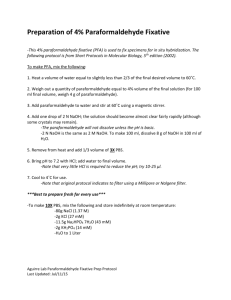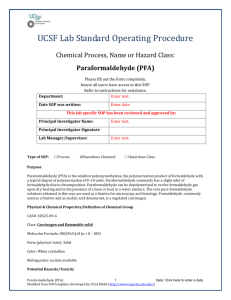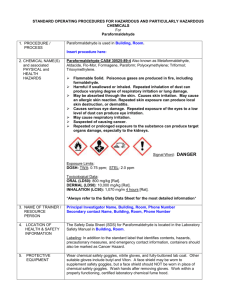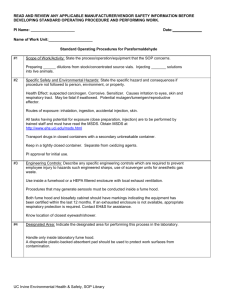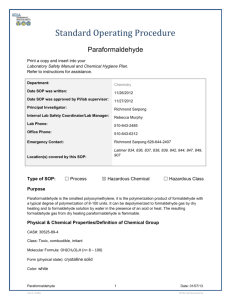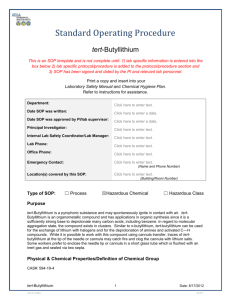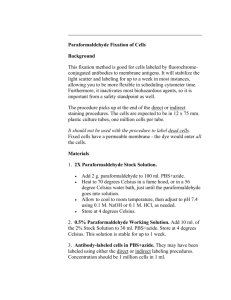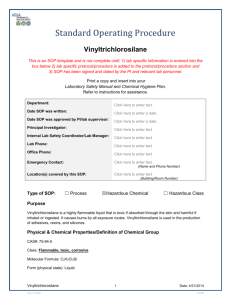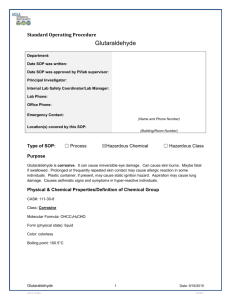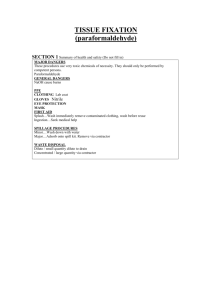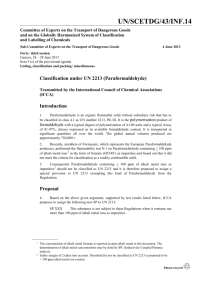Paraformaldehyde Monophosphate Buffer
advertisement
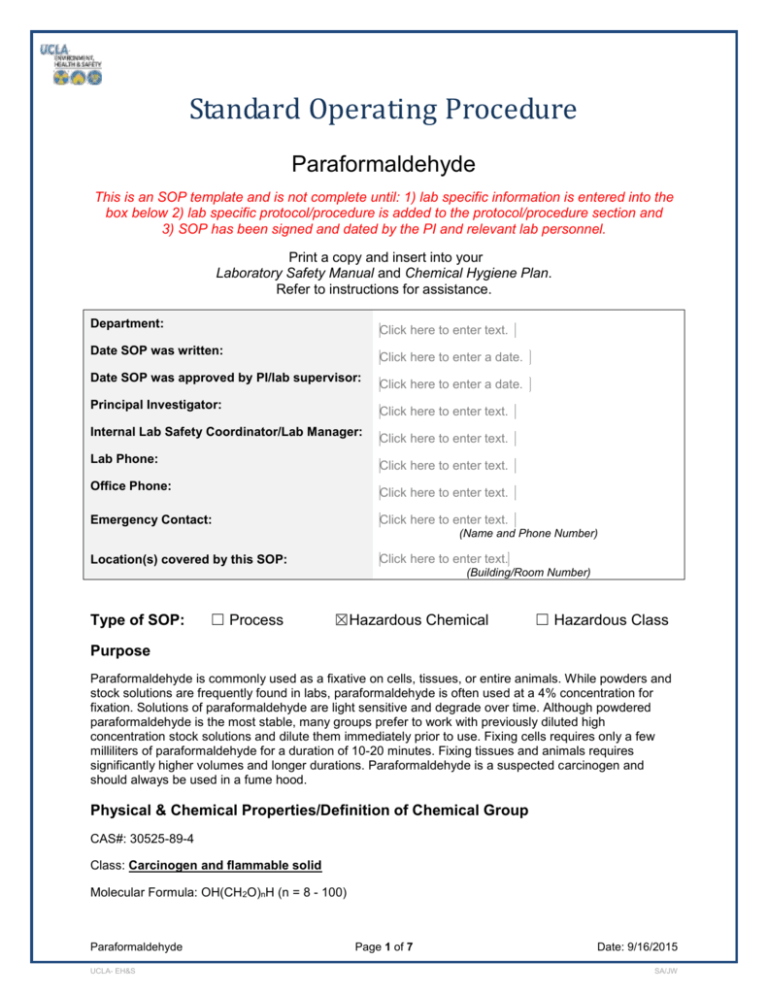
Standard Operating Procedure Paraformaldehyde This is an SOP template and is not complete until: 1) lab specific information is entered into the box below 2) lab specific protocol/procedure is added to the protocol/procedure section and 3) SOP has been signed and dated by the PI and relevant lab personnel. Print a copy and insert into your Laboratory Safety Manual and Chemical Hygiene Plan. Refer to instructions for assistance. Department: Click here to enter text. Date SOP was written: Click here to enter a date. Date SOP was approved by PI/lab supervisor: Principal Investigator: Click here to enter a date. Click here to enter text. Internal Lab Safety Coordinator/Lab Manager: Lab Phone: Click here to enter text. Click here to enter text. Office Phone: Click here to enter text. Emergency Contact: Click here to enter text. (Name and Phone Number) Click here to enter text. Location(s) covered by this SOP: (Building/Room Number) Type of SOP: ☐ Process ☒Hazardous Chemical ☐ Hazardous Class Purpose Paraformaldehyde is commonly used as a fixative on cells, tissues, or entire animals. While powders and stock solutions are frequently found in labs, paraformaldehyde is often used at a 4% concentration for fixation. Solutions of paraformaldehyde are light sensitive and degrade over time. Although powdered paraformaldehyde is the most stable, many groups prefer to work with previously diluted high concentration stock solutions and dilute them immediately prior to use. Fixing cells requires only a few milliliters of paraformaldehyde for a duration of 10-20 minutes. Fixing tissues and animals requires significantly higher volumes and longer durations. Paraformaldehyde is a suspected carcinogen and should always be used in a fume hood. Physical & Chemical Properties/Definition of Chemical Group CAS#: 30525-89-4 Class: Carcinogen and flammable solid Molecular Formula: OH(CH2O)nH (n = 8 - 100) Paraformaldehyde UCLA- EH&S Page 1 of 7 Date: 9/16/2015 SA/JW Form (physical state): Solid Color: White crystalline Boiling point: no data available Potential Hazards/Toxicity Carcinogen. May cause sensitization by skin contact. Risk of serious damage to the eyes. Harmful by inhalation and oral ingestion. Irritating to respiratory tract and skin. Flammable. Personal Protective Equipment (PPE) Respirator Protection Where risk assessment shows air-purifying respirators are appropriate use a full-face particle respirator type N99 (US) or type P2 (EN 143) respirator cartridges as a backup to engineering controls. If the respirator is the sole means of protection, use a full-face supplied air respirator. Use respirators and components tested and approved under appropriate government standards such as NIOSH (US) or CEN (EU). Respirators should be used only under any of the following circumstances: As a last line of defense (i.e., after engineering and administrative controls have been exhausted). When Permissible Exposure Limit (PEL) has exceeded or when there is a possibility that PEL will be exceeded. Regulations require the use of a respirator. An employer requires the use of a respirator. There is potential for harmful exposure due to an atmospheric contaminant (in the absence of PEL) As PPE in the event of a chemical spill clean-up process Lab personnel intending to use/wear a respirator mask must be trained and fit-tested by EH&S. This is a regulatory requirement. (https://www.ehs.ucla.edu/ep/ih/resp) Hand Protection Handle with nitrile or chloroprene gloves. Gloves must be inspected prior to use. Use proper glove removal technique (without touching glove's outer surface) to avoid skin contact with this product. Dispose of contaminated gloves after use in accordance with applicable laws and good laboratory practices. Wash and dry hands. NOTE: Consult with your preferred glove manufacturer to ensure that the gloves you plan on using are compatible with Paraformaldehyde. Refer to glove selection chart from the links below: http://www.ansellpro.com/download/Ansell_8thEditionChemicalResistanceGuide.pdf OR http://www.allsafetyproducts.com/glove-selection-chart-chemical-breakthrough-ratings.html OR http://www.showabestglove.com/site/default.aspx OR http://www.mapaglove.com/ Eye Protection ANSI approved safety glasses or goggles. Paraformaldehyde UCLA- EH&S Page 2 of 7 Date: 9/16/2015 SA/JW Skin and Body Protection Flame resistant lab coats should be worn. These laboratory coats must be appropriately sized for the individual and be buttoned to their full length. Laboratory coat sleeves must be of a sufficient length to prevent skin exposure while wearing gloves. Full length pants and close-toed shoes must be worn at all times by all individuals that are occupying the laboratory area. The area of skin between the shoe and ankle should not be exposed. Hygiene Measures Avoid contact with skin, eyes and clothing. Wash hands before breaks and immediately after handling the product. Engineering Controls Work with this chemical in a certified ducted fume hood. Facilities storing or utilizing this material should be equipped with an eyewash facility and a safety shower. First Aid Procedures If inhaled Move person into fresh air. If not breathing, give artificial respiration. If breathing is difficult, give oxygen. Consult a physician. In case of skin contact Flush with plenty of water for at least 15 minutes while removing contaminated clothing. Take victim immediately to hospital. In case of eye contact Flush eyes with plenty of water for at least 15 minutes lifting upper and lower eyelids and removing contact lenses. Consult a physician. Continue rinsing eyes during transport to the hospital. If swallowed Never give anything by mouth to an unconscious person. Get medical aid immediately. Do NOT induce vomiting. If conscious and alert, rinse mouth with water. Special Handling and Storage Requirements Precautions for safe handling Avoid contact with skin and eyes. Avoid formation of dust and aerosols. Provide appropriate exhaust ventilation at places where dust is formed. Keep away from sources of ignition - No smoking. Take measures to prevent the build up of electrostatic charge. Conditions for safe storage Keep container tightly closed in a dry and well - ventilated place. Recommended storage temperature: 2 - 8 °C Spill and Accident Procedure Chemical Spill Dial 911 and x59797 Spill – Assess the extent of danger. Help contaminated or injured persons. Evacuate the spill area. Avoid breathing vapors. If possible, confine the spill to a small area using a spill kit or absorbent material. Keep others from entering contaminated area (e.g., use caution tape, barriers, etc.). Small (<1 L) – If you have training, you may assist in the clean-up effort. Use appropriate personal protective equipment and clean-up material for chemical spilled. Double bag spill waste in clear plastic bags, label and take to the next chemical waste pick-up. Large (>1 L) – Dial 911 (or 310-825-1491 from cell phone) and EH&S at x59797 for assistance. Paraformaldehyde UCLA- EH&S Page 3 of 7 Date: 9/16/2015 SA/JW Chemical Spill on Body or Clothes – Remove clothing and rinse body thoroughly in emergency shower for at least 15 minutes. Seek medical attention. Notify supervisor and EH&S at x59797 immediately. Chemical Splash Into Eyes – Immediately rinse eyeball and inner surface of eyelid with water from the emergency eyewash station for 15 minutes by forcibly holding the eye open. Seek medical attention. Notify supervisor and EH&S at x59797 immediately. Medical Emergency Dial 911 or x52111 Life Threatening Emergency, After Hours, Weekends And Holidays – Dial 911 (or 310-825-1491 from cell phone) or contact the Ronald Reagan UCLA Medical Center (emergency room) directly at x52111 (located at 757 Westwood Plaza, enter from Gayley Avenue). Note: All serious injuries must be reported to EH&S at x59797 within 8 hours. Non-Life Threatening Emergency – Go to the Occupational Health Facility (OHF), x56771, CHS room 67-120 (This is on the 6th floor, 7th corridor, room 120. Enter through the School of Dentistry on Tiverton Drive and proceed to the “O” elevator to the 6th floor.)Hours: M - F, 7:30 a.m. to 4:30 p.m. At all other times report to Ronald Reagan UCLA Medical Center (emergency room) at x52111. Note: All serious injuries must be reported to EH&S at x59797 within 8 hours. Needle stick/puncture exposure (as applicable to chemical handling procedure) – Wash the affected area with antiseptic soap and warm water for 15 minutes. For mucous membrane exposure, flush the affected area for 15 minutes using an eyewash station. Page the needle stick nurse by dialing 231 from a campus phone, enter 93333 when prompted and then enter your extension. Hours: M – F, 8:00 a.m. to 4:00 p.m. At all other times report to Ronald Reagan UCLA Medical Center (emergency room) at x52111. Note: All needle stick/puncture exposures must be reported to EH&S at x59797 within 8 hours. Decontamination/Waste Disposal Procedure Wearing proper PPE, decontaminate equipment and bench tops using soap and water. Dispose of the used Paraformaldehyde and disposables contaminated with Paraformaldehyde as hazardous waste. General hazardous waste disposal guidelines: Label Waste Affix an on-line hazardous waste tag on all waste containers using the WASTe Online Tag Program https://ehs.ucop.edu/waste as soon as the first drop of waste is added to the container Store Waste Store hazardous waste in closed containers, in secondary containment and in a designated location Double-bag dry waste using transparent bags https://www.ehs.ucla.edu/hazwaste/management/containers Waste must be under the control of the person generating & disposing of it Dispose of Waste Dispose of regularly generated chemical waste within 90 days Call EH&S at x61887 for questions Empty Containers o Dispose as hazardous waste if it once held extremely hazardous waste (irrespective of the container size) https://www.ehs.ucla.edu/hazwaste/types/extremely-hazardous o Consult waste pick-up schedule https://www.ehs.ucla.edu/hazwaste/management/pick-ups Prepare for transport to pick-up location Check on-line waste tag Write date of pick-up on the waste tag Use secondary containment Paraformaldehyde UCLA- EH&S Page 4 of 7 Date: 9/16/2015 SA/JW Safety Data Sheet (SDS) Location Online SDS can be accessed at http://msds.ehs.ucla.edu. Protocol/Procedure Amounts covered by this SOP: 0 – 100 g solid paraformaldehyde from 500 g reagent bottle Conditions covered by this SOP: 2°C - 26°C Paraformaldehyde should always be handled wearing proper PPE in a fume hood. Although paraformaldehyde is commonly used as a 4% solution to fix tissues there are numerous ways of preparing stock and working dilutions. Preparation from powder 1. Prepare 2x sodium monobasic phosphate according to the recipe below. 2. Heat this solution to 60°C and add paraformaldehyde powder. 3. While stirring solution add 10N sodium hydroxide dropwise until solution clears. 4. Then pH 8% PFA to between 7.2 and 7.4. 5. Add an equivalent volume of water to 8% PFA to make a working dilution of 4% PFA. 6. 8% PFA is stable up to 1 week when protected from light and stored at 4°C. Sodium Monobasic Phosphate Concentration 2x Buffer Sodium Phosphate Monobasic (NaPO4) 33.75g Sodium hydroxide (NaOH) 7.72g 700mL of ddH2O Then pH to 7.3 Bring to 1L Then Dilute to desired working concentration. Total 1L Sodium Monobasic Phosphate Plus PFA 8% solution 2X Buffer Sodium Phosphate Monobasic (NaPO4) PFA (Paraformaldehyde Add 10N Sodium hydroxide (NaOH) drop wise until clear. Then bring pH to 7.2-7.4 Bring solution to 1L using 2X NaPO4 Buffer. Filter at the End. Total 800mL 80g 1L 7. For 250 ml PFA, add 10g of Paraformaldehyde to about 200mL of H20. 8. Heat to 60°C in fume hood, while stirring, and add 1-3 drops of NaOH. Solution should become clear. 9. Add 25mL of 10X PBS and pH to 7.2-7.4. Bring final volume to 250mL. NOTE Any deviation from this SOP requires approval from PI. Documentation of Training (signature of all users is required) Paraformaldehyde UCLA- EH&S Page 5 of 7 Date: 9/16/2015 SA/JW Prior to conducting any work with Paraformaldehyde, designated personnel must provide training to his/her laboratory personnel specific to the hazards involved in working with this substance, work area decontamination, and emergency procedures. The Principal Investigator must provide his/her laboratory personnel with a copy of this SOP and a copy of the SDS provided by the manufacturer. The Principal Investigator must ensure that his/her laboratory personnel have attended appropriate laboratory safety training or refresher training within the last one year. Principal Investigator SOP Approval Print name __________________________Signature___________________________ Approval Date: I have read and understand the content of this SOP: Name Signature Date Click here to enter text. Click here to enter a date. Click here to enter text. Click here to enter a date. Click here to enter text. Click here to enter a date. Click here to enter text. Click here to enter a date. Click here to enter text. Click here to enter a date. Click here to enter a date. Click here to enter text. Click here to enter text. Click here to enter a date. Click here to enter text. Click here to enter a date. Click here to enter text. Click here to enter a date. Click here to enter text. Click here to enter a date. Click here to enter text. Click here to enter a date. Click here to enter text. Click here to enter a date. Click here to enter text. Click here to enter a date. Click here to enter text. Click here to enter a date. Paraformaldehyde UCLA- EH&S Page 6 of 7 Date: 9/16/2015 SA/JW Click here to enter text. Paraformaldehyde UCLA- EH&S Click here to enter a date. Page 7 of 7 Date: 9/16/2015 SA/JW
